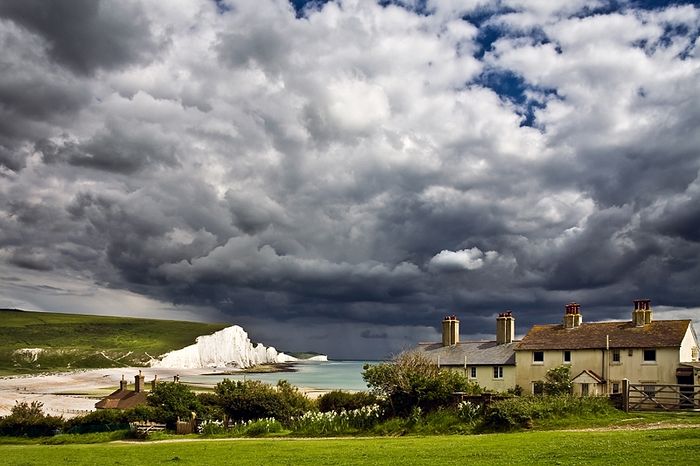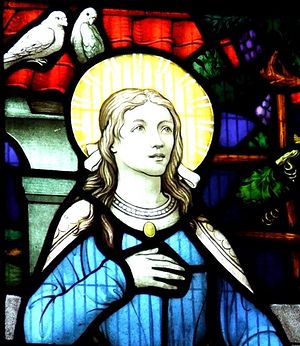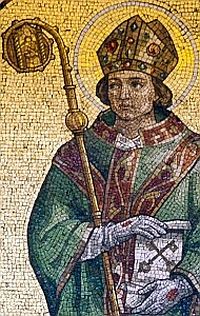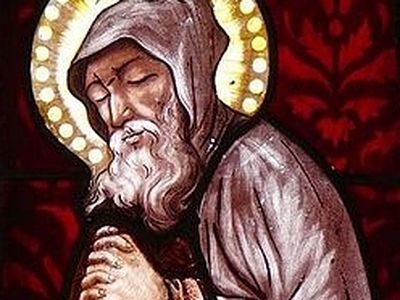Introduction
Having written of the saints of East Anglia, Essex and Kent, I have been asked to write of the saints of the fourth of the seven early English kingdoms, Sussex, the Kingdom of the South Saxons. Though not so far to the south of London, just beyond Surrey and Kent and stretching to the south coast, hence ‘Sussex by the sea’, Sussex has a reputation for being separate from the rest of England. Perhaps this is because of its downs, or hills, and forest, which in times past cut it off from others. In any case, as a result, just like the people of Essex, local people, in both east and west Sussex, have a reputation for independence and an aversion to being forced into anything. This is expressed in the Sussex motto, ‘We wunt be druv’ (We won’t be driven/pushed around).
The English settlement of Sussex began in the year 477 with a certain leader Aelle, who landed on the coast, consolidated his territory and was eventually recognised as the first overlord of southern Britain. By the second half of the seventh century the western corner of Sussex around Selsey and Chichester had become the political centre of the kingdom. In the 660s-670s King Ethelwalh of Sussex formed an alliance with the Mercian King Wulfhere. As Mercia’s first Christian king, Wulfhere insisted that Ethelwalh convert to Christianity. Wilfrid, the exiled Bishop of York and future saint, came to Sussex in 681 and with King Ethelwalh’s approval set up a mission to convert Sussex to Christ, his centre in Selsey.
At the end of the 8th century, Aldwulf was probably the last independent king of Sussex, after which Sussex like others came increasingly under Mercian rule. But Mercia’s grip was in turn shattered in 825, when Sussex and the other southern kingdoms came under the control of Wessex which later grew into the kingdom of England. Orthodox Sussex is marked by three saints. These are:
St Leofwynn (Lewina/Lewinna), Protomartyr of Sussex (+ c. 670)
Sussex was the last of the seven kingdoms of England to become Christian and east Sussex remained pagan longest of all. However, even before St Wilfrid’s organized missionary labours in 681, there were isolated Christians here. For example, a Sussex man called Damian had become Bishop of Rochester in Kent in the 650s and King Ethelwalh had been baptised before St Wilfrid. And before Wilfrid there was for a time a small monastery of five or six monks at Bosham in west Sussex, founded in c. 670 by a wandering Irish monk called Dicul (Deicola), later St Dicul (feast: 18 April).
St Leofwynn was another such isolated Sussex Christian, being martyred in c. 670, almost certainly by fellow countrymen who were still pagan and she was not a Briton, as can be ascertained by her name. About three centuries after her martyrdom her wonderworking relics were solemnly translated to a St Andrew’s church near Seaford in east Sussex, so the place of her sufferings must have been nearby. This St Andrew’s church where her miraculous relics were venerated in early English times was perhaps in Alfriston, an attractive village four miles from Seaford. However, others have suggested nearby Bishopstone, which also has a church dedicated to St Andrew dating back to the eighth century.
Most of our knowledge of St Leofwynn comes from an account of the theft of her relics in 1058 for a monastery in Berg in Flanders. After the Norman occupation nearly every memory of the saint disappeared in England, though she was a much-loved intercessor in her new home. In 1558 Berg was captured by French Protestants and the relics of Saint Leofwynn disappeared except for one rib. This was venerated at the monastery until the French Revolution when it disappeared. In 1928 a priest in Berg rediscovered the relic, but when his church was almost destroyed during a bombardment in the Second World War the relic was lost. St Leofwynn’s feast day is 24 July.
St Wilfrid, Apostle of Sussex (+ c. 709)
Sussex became a diocese when St Wilfrid began to convert the pagan kingdom between 681 and 685. St Wilfrid (c. 633 – c. 709) was a Northumbrian noble who became a monk and then Bishop of Northumbria. Exiled by the Northumbrian king who had quarrelled with him, Bishop Wilfrid spent these years of exile in Selsey in west Sussex, where he founded his see with a monastery on an estate of 87 hides, granted to him by King Ethelwalh. Here in the Manhood peninsula he began converting the pagan inhabitants to Christianity, before returning to Northumbria under its new king.
St Bede attributed Bishop Wilfrid’s ability to begin to convert Sussex in part to his teaching them how to fish. He also wrote that the Sussex area had been experiencing a drought for three years before Wilfrid, but miraculously when he arrived and started baptising converts, it began to rain. Bishop Wilfrid worked with another future saint, Erconwald, Bishop of London, in helping to set up the church in Sussex.
His mission was jeopardised when King Ethelwalh died during an invasion of his kingdom by Caedwalla of Wessex. However, Bishop Wilfrid had previously had contact with Cædwalla and may have served as his spiritual advisor before he invaded. And after Ethelwalh’s death Bishop Wilfrid became one of the new king’s advisors and he was converted. Cædwalla confirmed Ethelwalh’s grant of land in Selsey and Wilfrid built his cathedral nearby at the entrance to Pagham Harbour, in what is now Church Norton.
Cædwalla also sent Wilfrid west to the still pagan Isle of Wight with the aim of converting the inhabitants. The King gave Bishop Wilfrid a quarter of the land on the island as a gift. In 688 the King gave up his throne and went on a pilgrimage to Rome to be baptised, but died shortly afterwards. St Wilfrid may have been involved in founding monasteries in other parts of Sussex, but the evidence for this is based only on wording used in founding charters which resembles that used by him in other charters.
After this mission, Christians in Sussex were placed in the Diocese of Winchester and it was not until c. 715 that Edbert, Abbot of Selsey, was consecrated the first Bishop of Sussex. There were eventually around fifty monastic (minster) churches across Sussex and these centres supplied clergy for the surrounding areas. Examples are at Steyning, Singleton, Lyminster, Findon and Bishopstone. The jurisdiction of each of these churches seems to have matched the early land divisions, called rapes.
Thus, it was not until 200–300 years after conversion to Christianity began in the 680s that a network of local parish churches came into existence in Sussex, the earliest being recorded at Henfield in central Sussex in 770. Several monasteries were also established here in the early English period in, for example, Selsey, Lyminster, Aldingbourne, Beddingham, Chichester, Bosham, Ferring and South Malling. In 1075 the Normans transferred the cathedral for Sussex to nearby Chichester. The original cathedral at Selsey is now under the sea. St Wilfrid’s feast is on 12 October.
St Cuthman (Cuthmann) of Steyning
St Cuthman was born in about 681, probably at Chidham near Bosham in west Sussex. This would probably mean that St Wilfrid converted and baptised Cuthman and his parents. His life states that he was a shepherd who had to care for his paralysed mother after his father’s death.
According to one story, once while he was shepherding, Cuthman drew a line around the sheep with his staff so that he could leave to collect food. On his return he found that the flock had not left the invisible boundary. This miracle may have taken place in a field near Chidham, which for centuries was known as ‘St Cuthman’s Field’ or ‘St Cuthman’s Dell’. It was said that a large stone in the field on which the shepherd was in the habit of sitting had miraculous properties.
When Cuthman and his mother fell on hard times and were forced to beg from door to door, he built a one-wheeled cart, with a rope from the handles over his shoulders taking part of the weight, in which he moved her around with him. One day Cuthman and his mother set out east from his home, heading towards the rising sun. When the rope broke he improvised a new one from withies, deciding that when that broke he would accept it as a sign from God to stop at that place and build a church there.
The withy rope broke at a place called Steyning, some 25 miles from his birthplace and inland from central Sussex, at which he prayed: “Father Almighty, Thou hast brought my wanderings to an end, now enable me to begin this work. For who am I, Lord, that I should build a house to Thy name? If I rely on myself it will be of no use, but Thou wilt help me. Thou hast given me the desire to be a builder, make up for my lack of skill and bring the work of building this holy house to its completion.”
For, after building a hut for his mother and himself, Cuthman began work on a wooden church which he decided to dedicate to the fisherman-saint, Andrew, with help from the locals. As the church was nearing completion and Cuthman was having difficulty with a roof-beam, a stranger showed him how to mend it. When Cuthman asked his name, he replied: ‘I am he in whose name you are building this church’. We do not know when Cuthman reposed, but we can imagine it would have been in about 730.
Steyning became an important religious centre and St Cuthman’s grave became a place of pilgrimage in the tenth and eleventh centuries. In charters of William the Conqueror Steyning was sometimes called St Cuthman’s Market or St Cuthman’s Parish. At his birthplace at Chidham there developed a Guild of St Cuthman. Though he dedicated the church he founded at Steyning to St Andrew, the parish was recently rededicated to St Andrew and St Cuthman. A picture of him with his handcart is on Steyning’s town sign. His feast day is 8 February.
Conclusion
In September 1066 the Norman invaders landed at Pevensey in east Sussex near Kent and nearby erected a wooden castle at Hastings, from which they plundered the surrounding area. Thus, the Battle of Hastings took place in Sussex, fought against the English King Harold, who had strong connections with Sussex and whose chief seat was probably in Bosham in the west. It is likely that all the fighting men of Sussex were at the battle, as the county’s chief men were decimated and any that survived had their lands confiscated. As the heartland of King Harold, Sussex experienced some of the greatest and most tragic changes of any English county under the Normans.
Its Orthodoxy supplanted, in later history the west of the county had a tendency towards Catholicism, while the east of the county had a tendency towards Protestantism. Today, even these fragments of the Faith have largely been lost, but the memory of the three saints of Sussex, who all lived and reposed within a century of one another, has not been lost: Leofwynn the martyr from the east on whose blood the Church was founded, Wilfrid, the Apostle of Sussex who worked in the west, and Cuthman, the holy layman who settled near the centre of Sussex. What a fine thing it would be if one day an Orthodox church could be founded in Sussex, perhaps in its one city, Brighton, with its large population located very centrally along the coast between east and west, and dedicated to St Andrew the First-Called Apostle and the Three Saints of Sussex.










